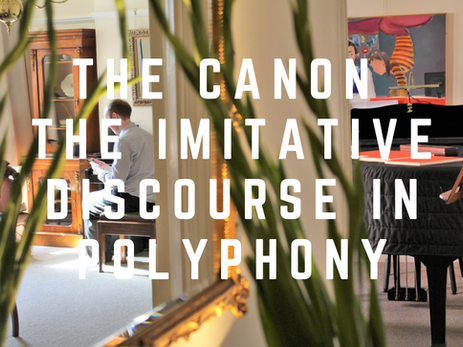Uncategorized
The Canon: The Imitative Discourse in Polyphony
INTRODUCTION
A Canon is the oldest of the imitative forms in Counterpoint.
It can be found from the XIII century and the XIV century, also called ars nova
in Italy and in France and it was this device that created what in later times was started to be known as the Fugue.
It is based on the imitation of melodies of the same content; this means that the melodies will have the same rhythm and intervals, where the melody which appears first in the piece is copied or imitated note for note (and consequently value for value) on each of the other parts.
In the canon, the beginning is taken literally, so the whole melodic structure of the voice is taken by transposition to another pitch (intervals from unisons, fourths, fifths, octaves, etc.).
Typical examples of this device are songs such as “Three blind mice” or “row, row, row your boat”, but one of the most famous examples of this resource was composed by the great genius of Counterpoint, J. S. Bach with his “,Art of the Fugue“.
Usually, the canonical treatment is applied merely to a portion of the piece, being the Art of the Fugue an exception.
When a melodic idea in one instrument or voice is imitated on a second voice that begins before the first has finished, we have a Canon.
The first voice is known as the “leader” or dux and the “follower” or comes. Dux and comes are Latin words that mean:
Dux is Latin for “leader” (from the noun dux, ducis, “leader, general”) and later for Duke and its variant forms (doge, duce, etc.). During the Roman Republic, dux could refer to anyone who commanded troops, including foreign leaders, but was not a formal military rank
Comes means companion, friend, or follower.
ELEMENTS OF A CANON
The canon has a start or HEAD, a development or BODY and a cadential gesture (the latter usually is the part that is subject to change)
The two variables to start writing a canon are the harmonic interval (the distance that we vertically measure between the first note of the leader and the follower) and the time interval. The most common interval is the octave. The time interval can be anything, from one note to many bars, although we will see there is a rule of two beats that composers tend to follow; if the interval is too long, the relationship between leader and follower will not be as clear in the mind of the listener, and if the distance is too near, the effect is too rushed. The listener cannot understand the melody of the leader fully before the follower imitates it.
EXAMPLES
https://www.youtube.com/watch?v=E1M_jEHJtrE&t=7shttps://www.youtube.com/watch?v=dwXXP24Sv_k&t=11shttps://www.youtube.com/watch?v=pSKkPT27Rpg&t=19shttps://www.youtube.com/watch?v=7tkc26aksmQ
PROCEDURES APPLIED IN THE IMITATION
Types of Canon
There are several ways to express a melodic discourse through the canon. There are many ways to establish different types of imitation in ,Counterpoint.
These are classified according to how the follower or comes will answer the leader or dux. By:
1. Movement
2. Pitch
3. Value
1. MOVEMENT
Direct: This is the most common of all, in which the intervals are imitated in the same direction
Inverted: In which the direction of the interval of the dux is imitated by inversion by the comes
Retrograde: In which the follower imitates the leader from the last note to the first, also known as “cancrizans” (or crab)
Inverted Retrograde: This is by far the least common, in which the follower imitates the leader from the last note to the first and uses the intervals in inversion
These last ones are the least common mainly for perceptual reasons: it is nearly impossible for any listener to perceive the correlation between the leader and the follower.
2. CANON BY PITCH
The most common interval is the octave, but you can also find it by the unison or any other interval. “The musical offering” of J.S. Bach is the perfect example of a dux that was imitated in all possible ways. In the fugues, the imitation is usually to the perfect fifth.
3. CANON BY VALUE OR RHYTHM
Another type of canon is the canon by “augmentation” or “diminution”. This is the name of a type in which the note values of the leading voice are double in the following voice as opposed to the canon “by diminution”, in which the corresponding note values are reduced by one half.
THE PERPETUAL CANON
Canons can lead back always to the beginning, and this allows as many repetitions as desired, making the theoretical possibility of the “perpetual canon” or also called infinitive canons, eternal canons, or circle canons.
What they all have in common is that they do not have any cadential ending unless one is added by the performers. This type of canon was extremely popular during Renaissance times.
In certain canons of the Art of the Fugue, the main body of the canon is perpetual and may be repeated ad libitum, but there is a coda at the end.
THE ENIGMA CANON
This last type of canon was trendy in Renaissance times; this was a sort of puzzle or ,musical riddle. The notation consists of a single melodic line, along with clefs or other clues to indicate the harmonic interval or time interval to be used, but this is left to the performers’ wit. The most famous is the one that J.S. Bach is holding in his hand in his own portrait:
Painted portrait of German composer and organist Johann Sebastian Bach (1685 – 1750) holding the ‘Canon triplex for Six Voices,’ Leipzig, Germany, painted by Elias Gottlieb Haussmann in 1746. (Photo by Hulton Archive/Getty Images)
LESSON VIDEOS
PART I
https://www.youtube.com/watch?v=9LuTXfjhza8&list=PLCeZxJIYVmnEhx5X9BOGyLTGrzxImS6ge&index=31
PART II
https://www.youtube.com/watch?v=kvXbCHvfvk0&t=23s
Do not miss my previous article: The Dissonance in the Baroque Period

